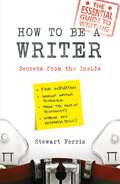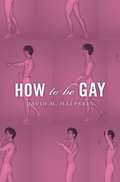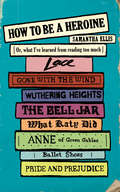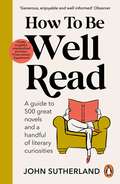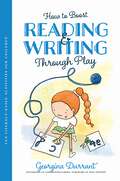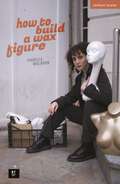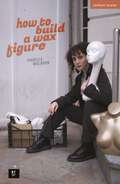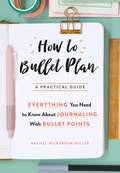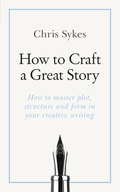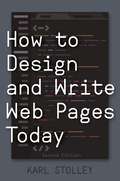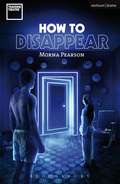- Table View
- List View
How to be a historian: Scholarly personae in historical studies, 1800–2000 (Current Practices in Ophthalmology)
by Herman PaulThis volume offers a stimulating new perspective on the history of historical studies. Through the prism of ‘scholarly personae’, it explores why historians care about attitudes or dispositions that they consider necessary for studying the past, yet often disagree about what virtues, skills, or competencies are most important. More specifically, the volume explains why models of virtue known as ‘personae’ have always been contested, yet also can prove remarkably stable, especially with regard to their race, class, and gender assumptions. Covering historical studies across Europe, North America, Africa, and East Asia, How to be a historian will appeal not only to historians of historiography, but to all historians who occasionally wonder: What kind of a historian do I want to be?
How to be a Roman: Band 14/ruby (Collins Big Cat)
by Scoular AndersonSo you want to be a Roman? Here is everything you need to know – in 20 easy stages. From the battle ground to building roads – find out the REAL facts to Roman living in this humorous non-fiction information book from Scoular Anderson.
How to be a Tudor: A Dawn-to-Dusk Guide to Everyday Life
by Ruth GoodmanThe real Wolf Hall - a time traveller's guide to daily life in Tudor EnglandThe Tudor era encompasses some of the greatest changes in our history. But while we know about the historical dramas of the times - most notably in the court of Henry VIII - what was life really like for a commoner like you or me? To answer this question, the renowned "method historian" Ruth Goodman has slept, washed and cooked as the Tudors did - so you don't have to! She is your expert guide to this fascinating era, drawing on years of practical historical study to show how our ancestors coped with everyday life, from how they slept to how they courted. Using a vast range of sources, she takes you back to the time when soot was used as toothpaste and the "upper crust" of bread was served to the wealthier members of the house. Exploring how the Tudors learnt, danced and even sat and stood according to the latest fashion, she reveals what it all felt, smelt and tasted like, from morning until night.
How to be a Writer: Secrets from the Inside
by Stewart FerrisIn this updated and expanded edition, Stewart Ferris uses his industry know-how to give you all the tips, tricks and inside knowledge you will need to become a successful writer, covering all types of writing from books to scripts and beyond. This guide is packed with advice to equip you with the skills you need to launch a writing career.
How to Be a Writer (Writer's Toolkit)
by David Quantick'How To Be A Writer is a collection of interviews with famous writers, performers and industry insiders that takes the reader through a writer’s day, from getting up to giving in. And, along the way, asks: When do you get ideas? When should you write? How do you deal with your money? Who do you have lunch with? And how do you keep going? Featuring JON RONSON, EMMA DONOGHUE, DENNIS KELLY, CAITLIN MORAN, JASON HAZELEY JOEL MORRIS, SUZANNE MOORE, CATHERINE ROSENTHAL, MARK ELLEN, JOHN PANTON JO UNWIN, MARTYN WAITES, MARK BILLINGHAM, ISZI LAWRENCE.
How to be Gay
by David M. HalperinA pioneer of LGBTQ studies dares to suggest that gayness is a way of being that gay men must learn from one another to become who they are. The genius of gay culture resides in some of its most despised stereotypes—aestheticism, snobbery, melodrama, glamour, caricatures of women, and obsession with mothers—and in the social meaning of style.
How To Be Gay
by David M. HalperinA pioneer of LGBTQ studies dares to suggest that gayness is a way of being that gay men must learn from one another to become who they are. The genius of gay culture resides in some of its most despised stereotypes—aestheticism, snobbery, melodrama, glamour, caricatures of women, and obsession with mothers—and in the social meaning of style.
How To Be A Heroine: Or, what I’ve learned from reading too much (Vintage Original Ser.)
by Samantha EllisCathy Earnshaw or Jane Eyre?Petrova or Posy?Scarlett or Melanie?Lace or Valley of the Dolls?On a pilgrimage to Wuthering Heights, Samantha Ellis found herself arguing with her best friend about which heroine was best: Jane Eyre or Cathy Earnshaw. She was all for wild, passionate Cathy; but her friend found Cathy silly, a snob, while courageous Jane makes her own way.And that’s when Samantha realised that all her life she’d been trying to be Cathy when she should have been trying to be Jane.So she decided to look again at her heroines – the girls, women, books that had shaped her ideas of the world and how to live. Some of them stood up to the scrutiny (she will always love Lizzy Bennet); some of them most decidedly did not (turns out Katy Carr from What Katy Did isn’t a carefree rebel, she’s a drip). There were revelations (the real heroine of Gone with the Wind? It's Melanie), joyous reunions (Anne of Green Gables), poignant memories (Sylvia Plath) and tearful goodbyes (Lucy Honeychurch). And then there was Jilly Cooper...How To Be A Heroine is Samantha’s funny, touching, inspiring exploration of the role of heroines, and our favourite books, in all our lives – and how they change over time, for better or worse, just as we do.
How to be Well Read: A guide to 500 great novels and a handful of literary curiosities
by John SutherlandAs the annual flood of published novels grows ever greater, it’s a hard a job to keep up, let alone sort the wheat from the chaff. Fortunately, literary sleuth and academic John Sutherland is on hand to do precisely that. In the course of over 500 wittily informative pieces he gives us his own very personal take on the most rewarding, most remarkable and, on occasion, most shamelessly enjoyable works of fiction ever written – the perfect reading list for the would-be literary expert. His taste is impressively eclectic. An appreciation of Apuleius’s The Golden Ass – arguably the first-ever novel – is followed by a consideration of Ian Fleming’s Goldfinger. The Handmaid’s Tale is followed by Hangover Square, Jane Eyre by Jaws. There are imposing Victorian novels, entertaining contemporary thrillers and everything in between, from dystopian works to romance.The flavour of each is brilliantly evoked and its relative merits or demerits assessed. At the same time, John Sutherland shows how the work fits into a broader context – whether that of the author’s life or of other books from the same genre or period. And he offers endless snippets of intriguing information: did you know, for example, that the Nazis banned Bambi or that William Faulkner wrote As I Lay Dying on an upturned wheelbarrow; that Voltaire completed Candide in three days, or that Anna Sewell was paid £20 for Black Beauty? Encyclopedic and entertaining by turns, this is a wonderful dip-in book, whose opinions will inform and on occasion, no doubt, infuriate. It is also effectively a history of the novel in 500 or so bite-sized pieces.
How to Become an Effective Journal Editor in Business and Management: A Guide to Developing Authors (How To Guides)
by Kathy Lund DeanThis timely guide provides detailed advice to help editors become more effective at aiding their authors’ scholarly development and creating ethical, values-based manuscript assessment processes. A key book for journal editors at any stage in their career, it sheds light on tried-and-true strategies for growing their editorial toolkit. Using specific real-world examples, Kathy Lund Dean encourages editors confidence in both practice and policy by learning foundational editorial skills. She draws upon 20 years of editorial experience to share crucial tips for all stages of the editorial process, from the identification of values to boosting journal visibility. She ultimately dispels the common assumption that journal editing merely involves ensuring author conformity to style, instead showing how effective journal editors must possess a dynamic mix of disciplinary expertise, constructive critique, and emotional intelligence to coax the best manuscripts from their authors. How to Become an Effective Journal Editor in Business and Management is vital for scholars who are considering an editorial role, particularly those focusing on business and management, leadership and education.. Current journal editors will also benefit from its examination of ethics, new resource identification and potentially difficult situations.
How to Behave Badly in Renaissance Britain
by Ruth GoodmanHistorian and popular BBC TV presenter Ruth Goodman, author of How to Be a Tudor, offers up a history of Renaissance Britain – the offensive language, insulting gestures, insolent behaviour, brawling and scandal of the sixteenth and seventeenth centuries – with practical tips on just how to horrify the Tudor neighbours.From royalty to peasantry, every age has its bad eggs, those who break all the rules and rub everyone up the wrong way. But their niggling, anti-social and irritating ways not only tell us about what upset people, but also what mattered to them, how their society functioned and what kind of world they lived in.In this brilliantly nitty-gritty exploration of real life in the Tudor and Stuart age, you will discover:- how to choose the perfect insult, whether it be draggletail, varlet, flap, saucy fellow, strumpet, ninny-hammer or stinkard- why quoting Shakespeare was very poor form- the politics behind men kissing each other on the lips- why flashing the inside of your hat could repulse someone- the best way to mock accents, preachers, soldiers and pretty much everything else besidesRuth Goodman draws upon advice books and manuals, court cases and sermons, drama and imagery to outline bad behaviour from the gauche to the galling, the subtle to the outrageous. It is a celebration of drunkards, scolds, harridans and cross dressers in a time when calling a man a fool could get someone killed, and cursing wasn’t just rude, it worked!‘Ruth is the queen of living history – long may she reign!’Lucy Worsley
How to Boost Reading and Writing Through Play: Fun Literacy-Based Activities for Children
by Georgina DurrantEven if children know their phonics and ABC's inside out and can read every book in their book bag, why is it still so difficult to get them to want to read and write? How do we begin to get our children excited about literacy? The answer might surprise you...let them play!Featuring 40 engaging play-based activities, this book makes literacy so fun that children won't notice they're also actively developing reading and writing skills. From blow painting words to making paper chain sentences, each activity can be done using household items and they are adaptable for children of any age and ability, making learning accessible for all. With charming black and white line illustrations to depict each activity, this is a great way to connect with children while helping to build their literacy skills at the same time.
how to build a wax figure (Modern Plays)
by Isabella WaldronI was the eyes and she was the bodyI mean that sounds poetic but really that's how it workedGirl meets anatomical wax sculptor.Anatomical wax sculptor meets Girl.They fall in love. Or something like that.Bea's older neighbour was her first love, her first cigarette, her first prosthetic eye. When Bea is invited to the Wellcome Collection to speak about her expertise making glass eyes, she finds herself unable to untie Margot from all that she does. As she tries to unpack her mentor's effect on her work, Bea must dissect for herself what love really looks like.Isabella Waldron's electric new play, how to build a wax figure, brings a fresh perspective on queer love, age-gap relationships, and ocularistry.
how to build a wax figure (Modern Plays)
by Isabella WaldronI was the eyes and she was the bodyI mean that sounds poetic but really that's how it workedGirl meets anatomical wax sculptor.Anatomical wax sculptor meets Girl.They fall in love. Or something like that.Bea's older neighbour was her first love, her first cigarette, her first prosthetic eye. When Bea is invited to the Wellcome Collection to speak about her expertise making glass eyes, she finds herself unable to untie Margot from all that she does. As she tries to unpack her mentor's effect on her work, Bea must dissect for herself what love really looks like.Isabella Waldron's electric new play, how to build a wax figure, brings a fresh perspective on queer love, age-gap relationships, and ocularistry.
How to Bullet Plan: Everything You Need to Know About Journaling with Bullet Points
by Rachel Wilkerson MillerSo what is a bullet journal? It’s a planner, to-do list and diary that will help you get your life together!This fun, practical guide shows you how to start and keep a bullet journal: a single notebook in which you write down all the things that you want to remember, or need to do, or you’ve already done – from every aspect of your life: work, home, relationships and hobbies.With colourful illustrations and easy tips to get you started, early adopter Rachel Wilkerson Miller explains how to make a bullet journal work for you – whether you want to create something simple or elaborate. Ideas for content include:- Lists of your to-dos and to-don’ts- Symbols that will make your lists efficient and effective- Calendars to plan your day, week, month or year- Trackers for your habits and goals (think health, money, travel)- Stationery such as washi tape, book darts and more!The phenomenon that is bullet journaling has led to thousands of journalers sharing their work on Pinterest, Instagram and Facebook. In How To Bullet Plan, Buzzfeed editor Rachel Wilkerson Miller tells you everything you need to know to start your own.
How to Conduct an Effective Peer Review (How To Guides)
by Gloria Barczak Abbie GriffinThis crucial book guides academics and researchers through the process of peer reviewing manuscript articles, outlining the methods and proficiencies required to write a high-quality review. Gloria Barczak and Abbie Griffin specifically highlight the importance of becoming a first-rate reviewer to early career scholars. Beginning with a working definition of a high-quality review, subsequent chapters detail the financial, career and personal benefits of peer reviewing for researchers, outline editors’ and authors’ expectations of reviewers, and offer a template for reviewing manuscripts effectively. Next, the book explicates sets of questions to consider in reviewing each section of a manuscript and features examples of reviews for actual journal submissions by the authors. Comprehensive in its approach, this book will be crucial for any early career social scientist hoping to effectively join the peer review process and write high-quality, meaningful reviews, as well as seasoned academics wishing to refine their skills.
How to Craft a Great Story: Teach Yourself Creating Perfect Plot and Structure (Teach Yourself)
by Chris SykesLEARN HOW TO PLOT AND STRUCTURE YOUR CREATIVE WRITING.How to Craft a Great Story takes you step by step through the process of creating a compelling and coherent plot and structure. It covers such basics as the traditional story arcs, and such advanced information as finding balance and marrying structure and form. Each chapter contains a diagnostic test, case studies, practical exercises and Aide Memoire boxes. Each chapter concludes with a reminder of the key points of the chapter (Focus Points) and a round-up of what to expect in the next (Next Step) will whet your appetite for what's coming and how it relates to what you've just read. Covering some of the most commonly raised questions in creative writing courses, it is perfect for anyone who needs the next step on from the basic 'how to write a novel'.ABOUT THE SERIESThe Teach Yourself Creative Writing series helps aspiring authors tell their story. Covering a range of genres from science fiction and romantic novels, to illustrated children's books and comedy, this series is packed with advice, exercises and tips for unlocking creativity and improving your writing. And because we know how daunting the blank page can be, we set up the Just Write online community at tyjustwrite, for budding authors and successful writers to connect and share.
How to Design and Write Web Pages Today
by Karl StolleyThis unique guidebook lays the foundations of contemporary mobile-first, responsive web design, offering writers, designers, and those who teach them a complete and up-to-date approach to web design.Are you looking to learn web design the right way? Not by using an off-the-shelf software package, but by creating customized sites in a way that gives you full control? This guide provides that ability even if you have no previous coding skills or experience.One of the critical challenges of modern web design is being able to write for the mobile web to reach those increasingly mobile-connected users. How to Design and Write Web Pages Today addresses this key objective while also explaining how to deliver improved experiences for users of desktop-style devices based on the constraints and challenges of mobile design. This user-friendly tutorial begins with background information to enable a better understanding of the web and its purpose and function as well as how to generate material for a website. Readers then learn about the three overarching concerns in the short- and long-term viability and usefulness of websites: accessibility, usability, and sustainability. Key technologies and techniques for web design—such as the HTML and CSS languages to the conceptual foundations of grid-based design—are next, followed by a thorough explanation of how to publish a site on the open web, from creating a viable site architecture to automating the publishing of content to the open web.
How to Design and Write Web Pages Today
by Karl StolleyThis unique guidebook lays the foundations of contemporary mobile-first, responsive web design, offering writers, designers, and those who teach them a complete and up-to-date approach to web design.Are you looking to learn web design the right way? Not by using an off-the-shelf software package, but by creating customized sites in a way that gives you full control? This guide provides that ability even if you have no previous coding skills or experience.One of the critical challenges of modern web design is being able to write for the mobile web to reach those increasingly mobile-connected users. How to Design and Write Web Pages Today addresses this key objective while also explaining how to deliver improved experiences for users of desktop-style devices based on the constraints and challenges of mobile design. This user-friendly tutorial begins with background information to enable a better understanding of the web and its purpose and function as well as how to generate material for a website. Readers then learn about the three overarching concerns in the short- and long-term viability and usefulness of websites: accessibility, usability, and sustainability. Key technologies and techniques for web design—such as the HTML and CSS languages to the conceptual foundations of grid-based design—are next, followed by a thorough explanation of how to publish a site on the open web, from creating a viable site architecture to automating the publishing of content to the open web.
How to Develop Children's Early Literacy: A Guide for Professional Carers and Educators (PDF)
by Ms Laurie Makin Dr Marian R Whitehead`Laurie Makin's and Marian Whitehead's book on How to Develop Children's Literacy stands out from the usual guides on child development and learning. The language is accessible and engaging. The text is empowering rather than condescending in tone and in content. Teacher trainees and people working with children, including parents, who are wanting a good depth of information quickly about children's early literacy development will find this book provides it' - Childforum, New Zealand Are you studying for a vocational qualification in early childhood? Are you a qualified teacher working with under-fives for the first time? Are you a nursery nurse or teaching assistant? Or are you thinking about doing one of these things? If so, this book is for you. The years before a child starts school are crucial in establishing strong foundations for literacy. This book addresses current issues relating to early literacy. The authors offer pragmatic ideas and information on key areas including: } literacy for babies and toddlers } literacy for preschool, daycare and nursery children } play, bilingualism, special needs and official curriculum frameworks. How to Develop Children's Early Literacy is a practical guide designed to support all early literacy educators.
How to Develop Children's Early Literacy: A Guide for Professional Carers and Educators
by Dr Marian R Whitehead Ms Laurie Makin`Laurie Makin's and Marian Whitehead's book on How to Develop Children's Literacy stands out from the usual guides on child development and learning. The language is accessible and engaging. The text is empowering rather than condescending in tone and in content. Teacher trainees and people working with children, including parents, who are wanting a good depth of information quickly about children's early literacy development will find this book provides it' - Childforum, New Zealand Are you studying for a vocational qualification in early childhood? Are you a qualified teacher working with under-fives for the first time? Are you a nursery nurse or teaching assistant? Or are you thinking about doing one of these things? If so, this book is for you. The years before a child starts school are crucial in establishing strong foundations for literacy. This book addresses current issues relating to early literacy. The authors offer pragmatic ideas and information on key areas including: } literacy for babies and toddlers } literacy for preschool, daycare and nursery children } play, bilingualism, special needs and official curriculum frameworks. How to Develop Children's Early Literacy is a practical guide designed to support all early literacy educators.
How to Direct Shakespeare
by Adrian NobleYou may be a student, or just starting out in the theatre profession, or an actor contemplating a switch to directing, or anyone dreaming of a life in the theatre. Know this: by developing and sharpening your skills on a Shakespeare text, you will be preparing yourself for your next production whatever or wherever that might be. Practical, inspirational and steeped in the wisdom and expertise of one of the great Shakespearean directors of our age, How to Direct Shakespeare guides you through each step of a production, from conception to final presentation to an audience. It includes close analysis of the text and provides strategies for focusing on the main action and structure; it considers dramatic energy and the world of the play, and illuminates these with examples drawn from a variety of Shakespeare's plays. It will assist you with creating your vision for the production as you collaborate with the design team, cast the play and work with actors in rehearsal. And it walks you through the encounter with the audience as you open your production.Drawing on examples from his work as artistic director of The Royal Shakespeare Company and subsequent directing work that has taken him all over the world, Noble shows how every production is shaped by a vision of the world - the interplay of the writer's vision and the director's interpretation of it. How to Direct Shakespeare will inspire and equip you as you develop your vision for your next production.
How to Direct Shakespeare
by Adrian NobleYou may be a student, or just starting out in the theatre profession, or an actor contemplating a switch to directing, or anyone dreaming of a life in the theatre. Know this: by developing and sharpening your skills on a Shakespeare text, you will be preparing yourself for your next production whatever or wherever that might be. Practical, inspirational and steeped in the wisdom and expertise of one of the great Shakespearean directors of our age, How to Direct Shakespeare guides you through each step of a production, from conception to final presentation to an audience. It includes close analysis of the text and provides strategies for focusing on the main action and structure; it considers dramatic energy and the world of the play, and illuminates these with examples drawn from a variety of Shakespeare's plays. It will assist you with creating your vision for the production as you collaborate with the design team, cast the play and work with actors in rehearsal. And it walks you through the encounter with the audience as you open your production.Drawing on examples from his work as artistic director of The Royal Shakespeare Company and subsequent directing work that has taken him all over the world, Noble shows how every production is shaped by a vision of the world - the interplay of the writer's vision and the director's interpretation of it. How to Direct Shakespeare will inspire and equip you as you develop your vision for your next production.
How to Disappear (Modern Plays)
by Morna PearsonWhen Helen Daniels from Neighbours died, Robert shut his door on the world. And he's not opened it since. Now his only connection to the outside world is through his younger sister Isla, who looks after them both whilst their father is away in Ibiza on 'business'.With only a strange menagerie of creatures (including an iguana called Scott and a corn snake called Charlene) to keep them company, each day looks pretty much the same as the last – until their quiet lives are interrupted by a visit from Jessica, a benefit assessor, determined to prove that Robert is fit for work.But Jessica soon realises that one size certainly does not fit all, as she suddenly stumbles across a secret about Robert that catapults her head first into a universe of infinite possibilities.Merging biting social commentary and fantasy in unexpected ways, How to Disappear is a pitch-black comedy which gives a voice to those who often go unheard.
How to Disappear (Modern Plays)
by Morna PearsonWhen Helen Daniels from Neighbours died, Robert shut his door on the world. And he's not opened it since. Now his only connection to the outside world is through his younger sister Isla, who looks after them both whilst their father is away in Ibiza on 'business'.With only a strange menagerie of creatures (including an iguana called Scott and a corn snake called Charlene) to keep them company, each day looks pretty much the same as the last – until their quiet lives are interrupted by a visit from Jessica, a benefit assessor, determined to prove that Robert is fit for work.But Jessica soon realises that one size certainly does not fit all, as she suddenly stumbles across a secret about Robert that catapults her head first into a universe of infinite possibilities.Merging biting social commentary and fantasy in unexpected ways, How to Disappear is a pitch-black comedy which gives a voice to those who often go unheard.



